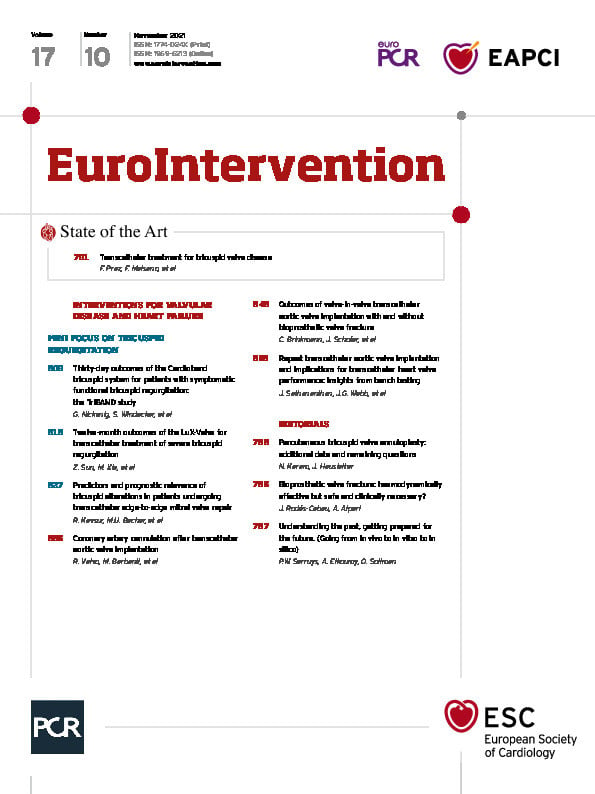Moderate to severe tricuspid regurgitation (TR) is common and associated with an increased risk of hospitalisation due to heart failure as well as cardiovascular mortality1,2. Tricuspid valve (TV) surgery is often a high-risk procedure with these patients due to late referrals, comorbidities (such as previous cardiac surgery), frailty and/or advanced age3,4. Transcatheter tricuspid valve repair (TTVR) was developed for patients with severe symptomatic TR who were deemed ineligible for cardiac surgery. Although several techniques are available, edge-to-edge repair is currently the most widely used TTVR technique5,6,7.
In this issue of EuroIntervention, Nickenig et al present the 30-day outcomes of the ongoing post-market TriBAND study in which direct annuloplasty TTVR was performed using the Cardioband™ tricuspid system (Edwards Lifesciences, Irvine, CA, USA)8. Of the 61 patients included in the study, 94% presented with at least severe TR. The mean tricuspid annular septolateral diameter was 45.5±4.5 mm and the left ventricular ejection fraction was 53.3±7.6%. The procedural time was 202.2±51.6 minutes. Device success (defined as successful device deployment and delivery system retrieval) was achieved in 96.7% of cases, and procedural success (30% reduction in the effective regurgitant orifice area [EROA]) in 83.9% of patients with available EROA (unreadable in 30 patients). Of the 52 patients with a 30-day follow-up, 74% were in New York Heart Association (NYHA) Functional Class I-II. There was a persistent post-procedural reduction in end-diastolic tricuspid septolateral annular diameter by 20%, and a reduction of TR to moderate or less in 59% at discharge and 69% at 30 days (p<0.001). Mid-right ventricular end-diastolic diameter, inferior vena cava diameter and right atrial volume decreased, while left ventricular stroke volume, estimated systolic pulmonary artery pressure and cardiac output increased. The clinical success rate (procedural success with no major adverse cardiac events [MACE] at 30 days), was 54.1% (data unavailable for 24 patients). All-cause mortality was 1.6%. There were right coronary artery (RCA) injuries requiring interventions in four patients (6.6%) as well as severe bleedings in seven patients (11.5%).
TTVR offers a great opportunity to treat moderate to severe TR in patients who are ineligible for TV surgery. While edge-to-edge repair is the most used technique, annuloplasty is a potential alternative, particularly in patients with large TV annuli. This first analysis of the ongoing TriBAND study, despite the missing echocardiographic data and incomplete 30-day follow-up (<2/3), shows the promising results achievable by experienced teams using the Cardioband tricuspid system in the commercial set-up. The results compare well with those of the TRI-REPAIR study8 and confirm the improvement in right ventricular and TV dimensions observed with edge-to-edge repair5,6,7.
Several issues still need to be addressed: 1) tools are needed to select the optimal technique –tricuspid annuloplasty versus edge-to-edge repair versus TV replacement– for a given patient. Characterisation of TV anatomies, including leaflet tethering, should be reported for patients undergoing TV annuloplasty to guide future patient selection for this therapy; 2) a relatively high rate of procedural and early complications, including RCA injury and bleedings, were observed in this study, despite careful selection in experienced centres. Hopefully, improvements in selection criteria, procedural planning, site experience, imaging techniques (including intracardiac echocardiography), as well as the introduction of the next-generation Cardioband tricuspid system, will result in fewer complications and radiation exposure with shorter procedural times; 3) the durability of TR reduction with the current Cardioband tricuspid system needs to be estimated, and the rate of screening failures reported, as long implants for very large annuli are not currently available; 4) it will be interesting to see how the results of this interim analysis compare with the final results of the TriBAND study, after the enrolment of the total planned cohort and the completion of follow-up.
In conclusion, this interim analysis of the TriBAND study confirms the positive results of the TRI-REPAIR study but shows the need for further optimisation of procedural duration and selection tools. The respective roles of edge-to-edge and direct annuloplasty in the TTVR arsenal remain to be defined, including in relation to percutaneous TV replacement.
Conflict of interest statement
N. Karam has received consultant fees from Abbott Vascular and Edwards Lifesciences, and a research grant from Edwards Lifesciences. J. Hausleiter has received research support, speaker honoraria from and serves as consultant for Abbott Vascular and Edwards Lifesciences.
Supplementary data
To read the full content of this article, please download the PDF.

